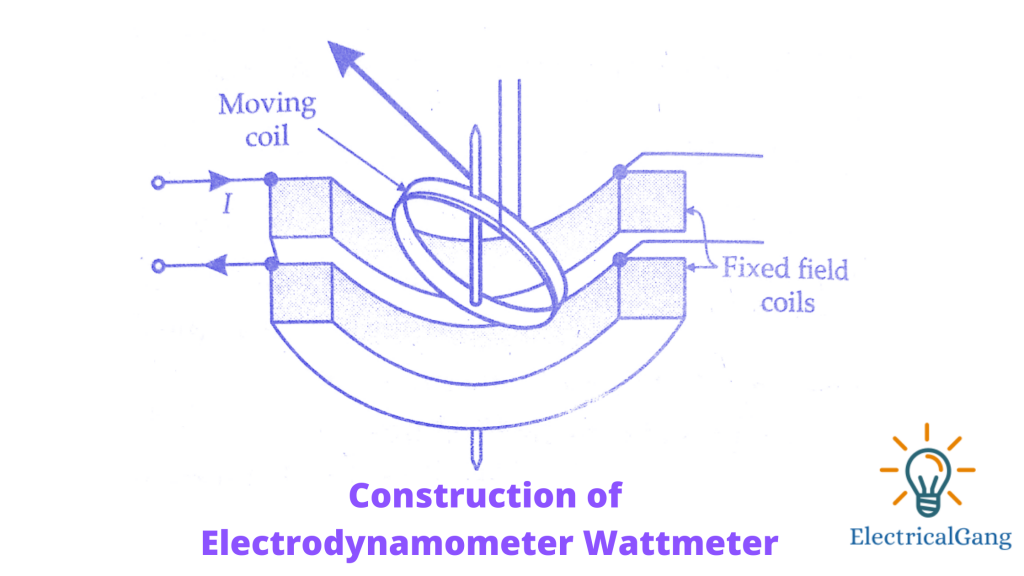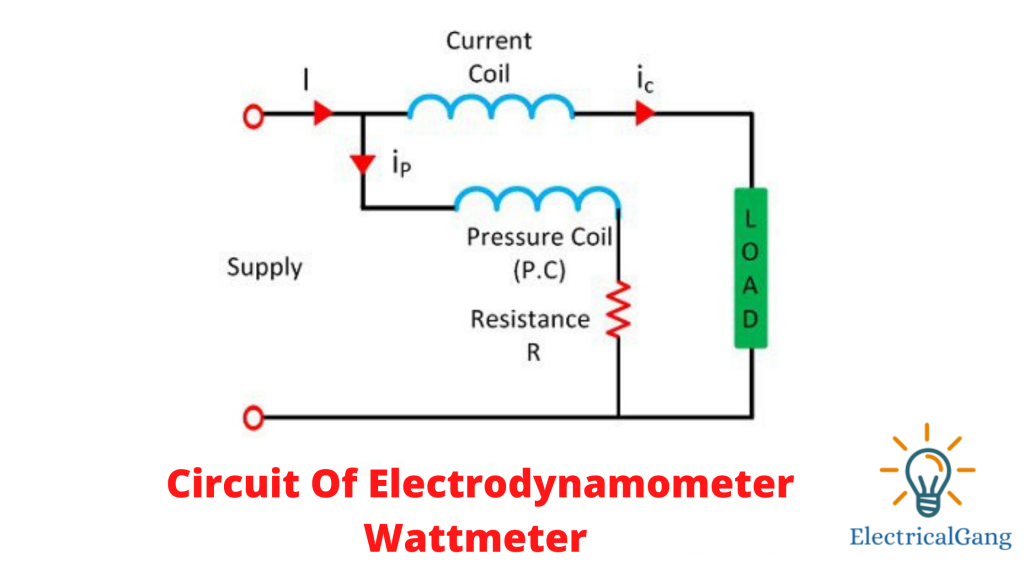
Hello friends, today we are going to talk about Electrodynamometer Wattmeter, its construction, working principle, and error.
What is Electrodynamometer Wattmeter?
Electrodynamometer Wattmeter is a machine whose function is related to the reaction between the magnetic fields of a fixed coil and a moving coil. It is used for both AC circuits and DC circuits.
The working principle of the Electrodynamometer Wattmeter is very straightforward and simple. Its function depends on the principle that a current-carrying conductor placed in a magnetic field experiences a mechanical force. This deflects the mechanical force indicator mounted on a calibrated scale.
Suggested Read: What Is Contactor? | Construction of Contactor
Construction of Electrodynamometer Wattmeter:
Some of its important parts are as follows:
| Sr. No. | Parts of Electrodynamometer Wattmeter |
| #1. | Fixed Coil |
| #2. | Moving Coil |
| #3. | Control |
| #4. | Damping |
| #5. | Scales and Pointers |

#1. Fixed Coil:
It is connected in series with the load which is considered the current coil. Because the crane is carried by it. It is divided into two parts to make the construction simpler and they are connected in series with each other. It produces a uniform electric field, which is essential for this device. This coil is constructed in such a way that it can carry current up to 20 Amperes.
#2. Moving Coil:
The moving coil is used as a pressure coil in this tool. Which is applied in parallel with the given power. So it flows in direct proportion to the current fluid voltage. The pointer is attached to the moving coil. The speed of the pointer is controlled with the help of a spring. The temperature of this increases as the current passes through the coil. Controls the flow of currents using a resistor that connects in series with a rotating coil.
#3. Control:
It provides controlling torque on the instruments. Gravity control and spring control are two types of this control system. A spring control system is used in these two Electrodynamometer Wattmeters as it aids in the motion of the pointer.
Suggested Read: What Is DC Motor? | DC Motor’s Working Principle
#4. Damping:
With the help of this, the movement of the director is reduced. In this, wetting torque is generated due to the friction of air. No other type of damping is used as they cause loss of useful magnetic flux.
#5. Scales and Pointers:
A linear scale is used in this device. Because the rotating coil rotates linearly. The device uses a knife-edge pointer to eliminate parallax errors caused by oversights.
Working Principle of Electrodynamometer Wattmeter:
The principle of the Electrodynamometer Wattmeter is very straightforward and simple. When it is placed in a magnetic field it is based on the principle of a conductor carrying current.
This will cause the pointer to move due to mechanical force. There are two types of coils, one fixed coil, and the other rotating coil. Fixed coils are used for carrying current. And in any circuit, it is connected in series with the load.
The rotating coil carries the current in every proportion of the voltage and is connected to this side of the voltage. The value of current is limited to the minimum value due to the large non-indicator resistance connected in series. Whose circuit diagram is shown below.

Working of Electrodynamometer Wattmeter:
Electrodynamometer Wattmeter has 2 coils as you mentioned above one is a static coil and the other is a rotating coil. The static coil is connected in series to know the power consumption.
Suggested Read: What Is Motor Winding | Types of Motor Winding
The given voltage is applied to the rotating coil thus the incoming current is controlled with the help of a resistor. Which are connected to it in series.
The moving coil on which the pointer is fixed is placed between the stationary coils. Two magnetic fields are generated due to current and voltage in a static coil. The pointer deflects the action of two magnetic fields as a reaction. Deflection is proportional to the force passing through it.
Theory of Electrodynamometer Wattmeter:
The circuit diagram of the Electrodynamometer wattmeter is as follows:

Instant torque performing on the pointer,
T1 = i1ip dM / dθ
Where ‘ip’ is the current going sideways in the pressure coil.
Equate the voltage in the circuit around the pressure coil,
V = √2Isin (-t-Φ)
If a coil with a resistive pressure is used in the current the current will be in phase with the voltage. The value of current is,
Ip = v / Rp = √2 (VI / Rp) sin ωt = √2IpSin t
The current flowing from the current coil when it is behind the voltage at the phase angle,
‘Ip’ = √2Isin (ωt-∅)
The current value in the pressure coil is very low. It is therefore treated as total load current. Is the torque acting on the coil,
Ti = √2Isin (-t- Φ) dM / dθ
The range from 0 to T is consolidated to obtain the moderate defection torque and is given by,
Ti = √2 (VI / Rp) cosΦdM / dθ
The controlling torque on the spring is,
Tc = Kθ
Errors of Electrodynamometer Wattmeter:
The common faults of the Electrodynamometer Wattmeter are as follows:
| Sr. No. | The error of the Electrodynamometer Wattmeter |
| #1. | Pressure Coil Inductance |
| #2. | Pressure Coil Capacitance |
| #3. | Errors Caused by Mutual Inductance Effect |
| #4. | Eddy Current Error |
| #5. | Stray Magnetic Field Error |
| #6. | Temperature Error |
#1. Pressure Coil Inductance:
This coil has a little too much inductance which makes it a little too far behind the current voltage. Which causes the power factor to lag and the meter to read higher.
Suggested Read: What is Transducer? | Types of Transducer | Application of Transducer
#2. Pressure Coil Capacitance:
The pressure coil also has inductance with a little more capacitance. Which has been helpful in increasing the power factor and this leads to reading errors.
#3. Errors Caused by Mutual Inductance Effect:
Mutual inductance between pressure and current coil produces an error. Error due to mutual inductance effect – Mutual inductance between pressure and current coil produces the error.
#4. Eddy Current Error:
It creates its own magnetic field in the coil, which affects the main current flowing through the coil. Thus, a reading error occurs.
#5. Stray Magnetic Field Error:
The stray magnetic field disrupts the main magnetic field of the electrodynamic and thermometer. Thus, affecting their reading.
#6. Temperature Error:
The change in temperature causes a change in the pressure coil resistance. The movement of the spring provides controlled torque due to this variation in temperature. There, a reading error occurs.
Advantages of Electrodynamometer Type Wattmeter:
They can be used to measure AC as well as DC stock for both as the scale is calibrated for both. The scale is the same up to a certain limit.
Most Commonly Asked Question:

What is Electrodynamometer Wattmeter?
Electrodynamometer Wattmeter is a machine whose function is related to the reaction between the magnetic fields of a fixed coil and a moving coil. It is used for both AC circuits and DC circuits. The working principle of the Electrodynamometer Wattmeter is very straightforward and simple. Its function depends on the principle that a current-carrying conductor placed in a magnetic field experiences a mechanical force. This deflects the mechanical force indicator mounted on a calibrated scale.
How is a wattmeter connected?
The current coil is connected in series with the load to carry circuit current and the potential coil is connected across the load in order to carry current proportional to the voltage.
What does a wattmeter indicate?
Wattmeter measures the electric power in watts of any circuit.
What 2 factors determine the turning force of a Wattmeter?
It depends on the strength of the magnetic field of both stationary and moving coils. Thus, this is all about the definition, construction, working principle, working, theory, and errors of the Electrodynamometer Wattmeter.
What happens if an electrodynamic type of wattmeter current coil is connected across the supply?
When an electrodynamic type wattmeter is used to measure AC power fixed coil splits into two parts, which are air-cored. This avoids hysteresis loss.
Like this post? Could you share it with your friends?
Suggested Read –
- Netflix Not Working on Vizio Smart TV
- The Ultimate Guide to Fixing Hisense TV Problems
- Alexa Device Is Unresponsive | Here’s How to Fix It
- What is a Stepper Motor? | Types of Stepper Motors
- Buchholz Relay in Transformers | The Definitive Guide